How do you tell a story across a variety of different media? Frank Rose writes in his book (The Art Of Immersion) about trans and cross media, how it should enable associates of the audience to be able to explore into a narrative on any level of intensity that they want to immerse themselves into. Furthermore, allowing audiences to identify a cross of platforms from not only the original text but also being able to engage with stories throughout an extensive range of platforms. There have become many developing ways of telling stories, and theorist Frank Rose describes these as ‘deep media’ and ‘transmedia’, suggesting that the current state we currently live in is still evolving. “In a transmedia story, content that form a narrative can be distributed on to multiple platforms” (convergenceishere.weebly.com). This tells us that the expectation for something that is marketed as cross platform should allow users to engage with a narrative across a wider spectrum. Dr. Pamela Rutledge discusses on her blog that due to the change in media content we have access to, individual media should labour equally as a separate story experience. Leading on to her debate that the concept of transmedia storytelling remains completely participatory, the audience they become involved actively with the text.
“Cross-media communications have to start somewhere. The idea forms and the process begins” (Davidson, 2010 p10). We can relate this to the fictional superhero character Spider-Man. Having made a first appearance in comic books, he evolved to become so much more. The original story’s developing from the comics were taken to the cinematic screen and opening a whole new universe from it origins.
“Cross-media experiences are participatory. They engage us to get us more actively involved in the media experiences and we are rewarded with more awareness and ownership” (Davidson 2010 p7). Due to the medias heavy influence we are considerably crushed about what content we are being provided with and are forced to consume. Even if we do not want to accept the mediated content that is provided to us. However, as users we have more control of what platforms we interrelate with. Arguably, this is the case with social media; we have full influence and control with what media we may or may not want to post. Although are we only posting content revolving around with what we are being fed from broadcasters? Henry Jenkins proposes, “members believe their contributions matter and feel some degree of social connection with one another…”(Henry Jenkins 2009 p12). For example, the ALS Ice Bucket Challenge, what started out as a charities way of raising money went on to become a virally circulated craze on social media. Having become a viral event, people were deviating away from its original charitable cause, and it became a trend of our participatory culture and the contributors were more concerned about their personal social media contributions rather than the cause of the charity. Additionally, what this portrays is that globally we have evolved from once caring and prioritising circumstances such as charity. Instead, deviating our attention towards social media sites, and embracing a social connection with one and other.
Franchised transmedia has become a dominant identity of movies produced out of Hollywood. It has developed into being part of the business production and alternatively is viewed as commercial storytelling across media platforms. Phenomenally there is a wide range of media platforms to be taken into consideration. For example, video games, books, and social media are all platforms of commercial storytelling, which globally are consumed and relied on during a daily basis. Ultimately as a nation we have become reliant on these media contents to for fill our everyday needs and pleasures. Every platform of media content has a dominant purpose, to entertain its target audience. However, various contents have their own unique intentions and different contents attract varied audiences founded upon personal interests and the unique features of the specific platform. It has become clear in our generation that a simple piece of media content such as a child’s storybook can now be staged as so much more.
It has become a common factor for one platform to piggyback off another; Hollywood blockbuster movies such as Spider-Man, Toy Story, and Transformers are all prime examples of this. Producers like Disney and Paramount make a leading use of this marketing strategy synergy, in order to make the maximize profit out of the original content. Domineering companies like these are classed as the most successful due to the global profit they receive from their movies. What separates the ‘big 5 Hollywood’ producers from others is not only the sizeable budget invested into films, but the recognition to produce other commercial products that can also attract not only the intent audience from the original source but a wider spectrum. Initiating a broader growth across all platforms. What this interaction is encouraging happens to be audience participation. In the case of Toy Story, Disney Pixar have used characters Buzz and Woody to connect globally in a wider range of media allowing the producers not only to tell stories through film but diverse additional methods.
Toy Story (1995-) has now become an enormous global franchise. During this textual analysis I will investigate how Walt Disney have maximised the possibility of creating Toy Story not only a set of films, but a whole lot more across binary media platforms. All 3 films set mass box office records grossing worldwide over $1.9 billion, with the second and third instalments of the franchise making it into the ‘Rotten Tomato’s’ top 100 all time movies. Toy Story has developed a ground breaking audience due to its film success. However, it has dispersed an audience across a wider range of cross media platforms, and so turned out to be an enormously successful franchise.
Toy Story has developed an adolescent loyal fan base. The release strategy from 1995-2010 has been configured for a purpose, and it has allowed every release of new film to connect with a new generation of child. Each generation of child developing a love and leading hunger for Toy Story’s main protagonists Woody and Buzz Lightyear. For example, the year Toy Story was first brought to cinema (1995) I was a small child who had a grand affection for the movie. Upon the release of Toy Story 3 (2010), at the age of 16, I was as keen as ever to see the film in the cinema. Having released Toy Story 3 15 years from the first, a new generation of younger children were discovering Toy Story for the first time. My younger brother had become part of that generation. He discovered Toy Story for the first time and immediately developed worship for all things relating to Toy Story.
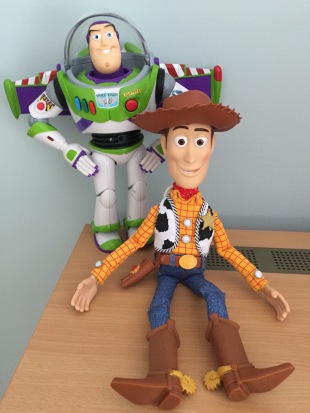
Leading me to ‘Figure 1’ shown here, what was originally mine as a child passed onto my brother, toy dolls of Woody and Buzz. Encouraging children to interact with content, and therefore putting into effect Henry Jenkins theory of audience participation? “Think of Star Wars, and all those action figures, and the fan fiction that came out of it – story transmuted to play and then to story again.” Henry Jenkins implies here that Media should not only be a visual aspect but a physique. Leading back to the release strategy, demonstrating to us that the lengthened release over a period of time, will not only uphold an original fan base but will create depth for growth and expansion. This theory can also be established upon the release of Toy Story 4, set for a 2017 release, a 7-year gap from the third showing that Disney have put this into effect for a reason, expanding a countless franchise.
Stereotypically, movies produced out of Hollywood have a basic basis for commercial merchandising production. This proved through video games, toy, posters and more. However, Pixar and Disney identified that with Toy Story this could be a complete vaster picture due to the volume of characters connected within the franchise. Furthermore, apart from the Hollywood merchandising basics Disney took Toy Story to a whole new magnitude of cross platform; they went on to produce spin off short films, television series, TV specials, an animated direct to video movie based on Buzz Lightyear, and most recognisably into theatrical presentations on Ice.
After the release of the third film, 2 short TV specials were produced. However, Disney needed somewhere to air these shows. They needed a large investment company that would be prepared to assist in the marketing and raising awareness of the shorts. Turning to SKY one of the world’s leading broadband and satellite TV providers, Disney devised a deal that would allow Sky to use Toy Story’s iconic recognised characters to market their product across a variety of media platforms, in return giving them release of these short TV specials across the SKY network. Demonstrating how media contents are clashed across platforms in order for commercial storytelling. Also, showing how the medias advertising strategies have changed making use of intertextuality. In the video shown here is the Sky advert, intertextuality is used with the 3 alien characters, saying ‘skyyy’, this being iconic of the original 3 films when they use the phrase ‘the clawww’.
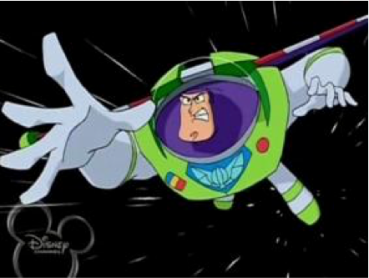
Following the release of the second film Disney delivered its first spin off animated TV series, ‘Buzz Lightyear of Star Command’. Airing on Disney Channel it allowed young fans of the protagonist to delve onto another platform of media, studying new narratives being told amongst a cross of platforms. From this TV series, it incorporated another connection of platform adding a spin off video game. Letting audiences engage with the video game platforms PlayStation and Gameboy. Arguably, you could say that this is a cross of platform within another, the TV series developing from the movie, and the video game developing from the TV series.
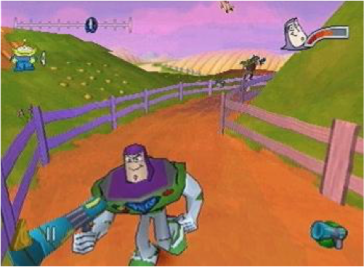
http://cdn4.spong.com (2000)
The video game incorporates missions and characters connected from the TV series. Creating within the game a short narrative, allowing users to be in the role-play of Buzz Lightyear. What applies to this is Blulmer and Katz theory of uses and a gratification for the audience, not only does it to deliver pleasures and entertainment but escapism from the everyday norm and a fantasy for audiences. Permitting operators of the game to interact visually with their desired character.
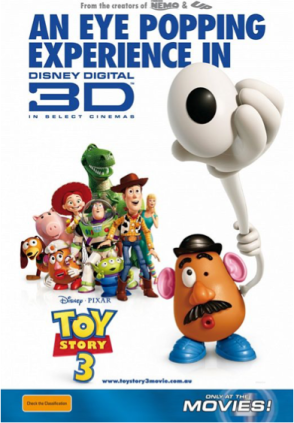
Given the box office success of Toy Story 3 scorching a ground breaking $110,307,189 in its opening weekend, and a total gross of $414,984,497 within the USA. Worldwide calculating a sum of $1,063,171,911 and further it went on to become of its era the highest grossing animated film of all time. Given the change of technology, Disney released Toy Story 3 on a whole new platform involving a brand new cinematic experience for audiences to delve themselves into. Imax CEO Richard L. Gelfond stated before the release of the film that, “we’re very excited to once again unite Disney Digital 3D with The IMAX Experience, and to do it for the long-awaited release of ‘Toy Story 3′ is a real treat. A film like this is designed to take audiences on an exciting thrill-ride adventure, making it a perfect match for both 3D and IMAX” (Richard Gelford – screenrant.com). The term ‘Imax Experience’ justifies that this new platform of viewing is bringing audiences something fresh and new, that will allow people to indulge within the cinema. It’s a fresh new technology that has taken the next step up from the 3D viewing and the original cinema experience. When going to the cinema it is something you are paying for and you want that to be an enjoyable experience, IMAX take that to the next new level. Only so many movies a year are broadcast in IMAX due to it’s costing and the quality of the film, only the very best films and directors get access to the filmmaking technology like IMAX. Film critic Scott Mendelson reported to the new ‘Huffington Post’ “this is some of the best 3D work yet in a cartoon…IMAX screen only increases the scope of the viewing experience…” (Scott Mendelson – Huffington Post.com). Justifying that this new cross platform of release strategy offers an audience a prestige alternative-viewing occurrence.
Prior to the anticipated release of Toy Story 3 in IMAX, Disney gave the loyal fans a chance to see the first two instalments in a whole new 3D dimension. A technology of the original release time period they would have never been able to have access to. For a limited short period Disney released these two films on the new 3D IMAX platform to allow viewers to buy into the new technology and viewing experience provided. Notably this was enforced as a release strategy by Disney creating a hype and buzz for Toy Story 3. This shows the current change of media platform, the technology we have access to now in comparison to the first release of Toy Story (1995) is substantial. The cinematic experience is evolving from the original wide screen, to an immersive 3D experience.
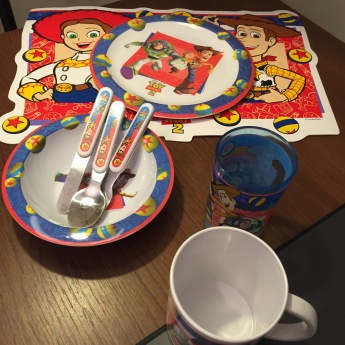
As I stated before, platforms of media don’t necessarily need to be visual, but can be also physical. The use of cutlery and kitchen appliances encourages user engagement from a young age, encouraging audience participation across these platforms. Effectively this can be considered educational as it encourages children from a young age how to make use of knives and forks etc. Nevertheless this is a simple marketing strategy from Disney incorporating synergy and creating products for parents to purchase for their kids as they develop a love for Buzz and Woody. I am aware of this because as you can see from my own personal content I was part of the audience engagement purchasing content across a variety of platforms from toys, kitchen appliances and video games.
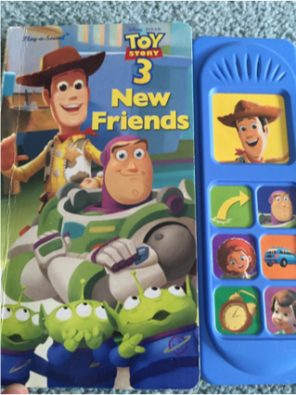
Furthermore, developing the idea of transmedia storytelling and transmedia intertextuality, characters Buzz and Woody appear across a whole variety of children’s books. This allows participators to interact with a new level and variety of story, engaging with new narratives, but still engaging with the familiar characters. Theorist Stravroula Kalogeras tell us in her book “storytelling is a narrative of events, and whether it is real or imagined, it conveys meaning” (Stravroula Kalogeras – P9 – 2014). What she potentially is suggesting here is that regardless of the original media content, due to the access of content we have available to us now we can cross boundaries between various content. “…Adds richness and detail to the story world, such as character backstories and secondary plot lines” (Dr Pamela Rutledge). For example, the release of Toy Story 3 brought the original rich content and story, but with the release of books as shown here, we can blur these connections together in order to tell cross media narratives and secondary plot lines, as Dr Rutledge suggests.
It has become a common nature within the new media for audiences to engage with content on a new level, and that’s by impersonating and mimicking the text to their own entertainment. Theorist Linda Hutcheon proposes that postmodernism mechanisms through parody and pastiche. These parodies and pastiches commonly are created in ludicrous ways to convey the comical approach, and in a manor that they were not originally for portrayal. Theorist Frederic Jameson discusses how pastiches have become a part of our new generation and postmodernism. Pastiche has become noticeable in popular culture, they do not parody a text but elements are reconstructed to create a new text. Jameson discusses how Star Wars mimics the Flash Gordon 1930’s science fiction series, with the opening text scrolling across the screen.
This has been the same case with the short animation on YouTube ‘Toon Story’, a pastiche of Toy Story. It’s tag line ‘the minute I step out of the room, the Toons come to life!’ It implies the similar narrative structure of Toy Story. As Andy leaves the room the toys come to life. As you can see from the video it piggybacks off the narrative structure that when Andy leaves the room the ‘toons’ come to life and active in his bedroom. Then when he comes back it’s a rush for everyone to resume their previous positions, alike Toy Story where the same narrative applies to the toys.
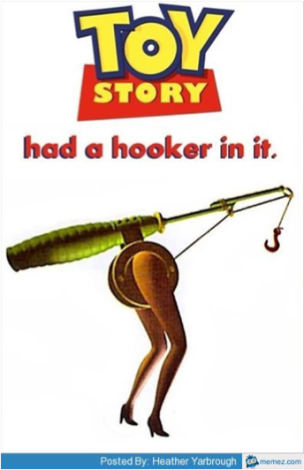
It’s a common factor for parody images to occur across dominantly social medias such as Twitter, Facebook and YouTube. Parody accounts have been created to mimic individuals and ideas, videos spoofing original content. Most commonly passed around the ‘Twittersphere’ would be memes. Memes often pieces of original visual media, along with inserted content. This tends to be a phrase either mocking the content or an active audience editing the media to his or her own amuses. Audiences remain no longer regulars who submissively accept what the media propose, but have developed into active intimates. As you can see here from figure 9, a poster from Toy Story, with one of the original characters fronted central. However, an active audience has engaged with this text inserting their own content, in order to create humour and expose another meaning to the text, targeted dominantly at an adult audience. Furthermore, this defending the impression that we now revolve around a culture that has become participatory. Not only actively participatory but also digitally participatory, showing the evolvement of our current state.
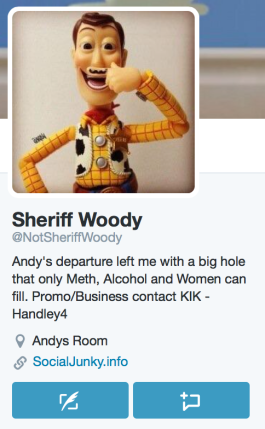
Twitter has established itself, as another popular platform of media, encouraging a social connection globally. However, parody accounts have become a form of audience participation across Twitter. They have been used to exploit the humour, and often mimic another person. This is the case with this ‘Sheriff Woody’ account. Put into place to mimic a child’s role model icon, exploiting the explicit content, tweeting irregular tweets revolving around sexual and alcohol content. Content that you would not associate Woody with during the films. The accounts demonstrate the postmodern period we leave in, as audiences actively are engaging with the content across another platform of media.
During this textual analysis, not only have I discovered how Toy Story covers media across an extensive foundation of platforms, but how as operators we interact with it and consume it. Technology is forever evolving, and therefore the media content we have access to will forever evolve also. This stood out to me dominantly when I learnt about the IMAX release strategy; Disney incorporated this prior to the release of the third film. This release platform shows how the media is changing, a 15-year period between the first and third film and a whole new cinematic experience is available for consumers. Furthermore, the ability to engage with transmedia storytelling has never been easier. Arguably producers make use of this only for commercial marketing purposes. However, audience participation is now being encouraged on such a higher profile spectrum. The film industry continues to abide by this transmedia storytelling philosophy, delivering consumers contents of media across a wide set of platforms. Offering ways of engaging with story’s across all platforms. Having investigated Toy Story across its 15-year period and what content was produced out of this; personally I was intrigued about the video games created out of the franchise.
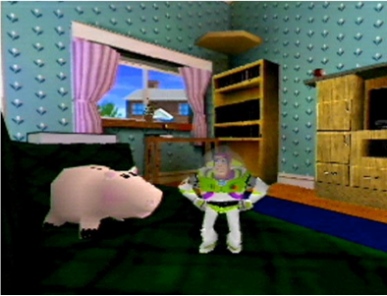
As a child I’ve grown up with PlayStation and during the second instalment of the film, a spin off game was produced as the same with the third. The media platform itself PlayStation has developed and changed phenomenally. This is shown by figure 9 & 10. Graphics have evolved and game play has over the 11-year period between these games.
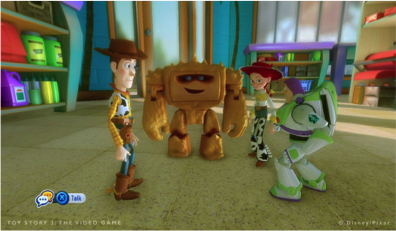
Globally, I feel now that as people, we feed off social connection with each other and interaction, having discovered this throughout the process of this analysis. Having researched participatory culture, it has concluded myself that everyone in this postmodern era requires to be part of a participatory culture. I have demonstrated this discussing the effects of parodies and pastiches, and how in this era it has become part of our generation. We have therefore succumbed to this postmodern change accepting it actively as an audience. Personally, I feel as if I am part of a participatory generation, I have portrayed this with the use of my personal content and how it has been passed through a generation.
To conclude, it is inevitable that we have become an active audience towards the media. The magnitude of access we have to throughout cross media platforms justifies this. The media consistently surrounds us and whether as an audience we are choosing to accept or decline the content, we are still being active within this and having a personal input. It is adamant that Henry Jenkins theory of participatory culture is cemented; audiences want to make contributions and feel engaged within a social connection. Cross media platforms are delivering us participatory experiences that allow us to actively intricate within a media experience. Giving us back a satisfaction, ownership and awareness of an active participatory culture. To finalise, what transmedia is offering us as users is the ability to engage with content that has been distributed, and commercially advertised across multi purpose media platforms.
Word Count: 3499
Bibliography
Dr. Pamela Rutledge, 2015. Transmedia Storytelling. Available from: http://athinklab.com/transmedia-storytelling/ [Accessed 21 May 2015].
Drew Davidson, 2010. Cross-Media Communications: An Introduction to the Art of Creating Integrated Media Experiences.
Henry Jenkins, 2009. Confronting The Challenges Of Participatory Culture.
Henry Jenkins, 2012. The Art Of Immersion. Available from: http://www.artofimmersion.com/interview.html/
Kathleen Bain, Transmedia & Crossmedia Convergence In a Connected World. Available from: http://convergenceishere.weebly.com/about-us.html [Accessed 20 May 2015].
Ross Miller, 2009. Toy Story 3 Gets IMAX. Screen Rant. Available from: http://screenrant.com/toy-story-3-imax-3d-release-plus-new-images-ross-38745/ [Accessed 20 May 2015].
Scott Mendelson, 2010. Toy Story 3: An IMAX 3D Experience (2010). Huffington Pose. Available from: http://www.huffingtonpost.com/scott-mendelson/huff-post-review—toy-st_b_618291.html [Accessed 20 May 2015].
Stravroula Kalogeras, 2014. Transmedia Storytelling and the New Era of Media Convergence in Higher Education. Palgrave Macmillan.
Video & Images
Toy Story 3D Double Feature Trailer. Video. Toy Story. Available from: https://www.youtube.com/watch?v=4tyE-t0zm_g [Accessed 21 May 2015].
The Claw – From Toy Story. Available from: https://www.youtube.com/watch?v=o31UcPeiUCc [Accessed 20 May 2015]
Sky Fibre Broadband Toy Story AD. Available from: https://www.youtube.com/watch?v=VuNPMvixgX8 [Accessed 20 May 2015].
1999.Toy Story 2 Printscreen. Photo. Available from: http://199.101.98.242/media/images/40308-Toy_Story_2_(Europe)-7.jpg [Accessed 20 May 2015].
Buzz Lightyear Of Star Command. Photo. Available from: http://pixar.wikia.com/Buzz_Lightyear_of_Star_Command [Accessed 20 May 2015].
Buzz Lightyear Of Star Command PS1. Photo. Available from: – http://cdn4.spong.com/screen-shot/b/u/buzzlighty33279/_-Buzz-Lightyear-of-Star-Command-PlayStation-_.jpg [Accessed 20 May 2015].
Toy Story IMAX Poster. Photo. Disney. Available from: http://www.pixartalk.com/wp-content/uploads/2010/04/ts3imaxposter.jpg [Accessed 20 May 2015].
Toy Story 3 PS3 Print screen. Photo. Available from: – http://image.jeuxvideo.com/images/x3/t/o/toy-story-3-xbox-360-005.jpg [Accessed 21 May 2015].
Heather Yarbou, A Hooker In Toy Story. Photo. Available from: http://www.memes.com/img/30724 [Accessed 20 May 2015].

